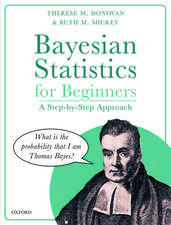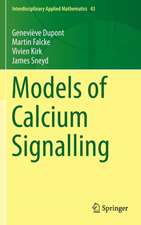Mathematical Physiology: II: Systems Physiology: Interdisciplinary Applied Mathematics, cartea 8/2
Autor James Keener, James Sneyden Limba Engleză Paperback – 27 oct 2008
In this second edition the coverage of basic principles has been expanded to include such topics as stochastic differential equations, Markov models and Gibbs free energy, and the selection of models has also been expanded to include some of the basic models of fluid transport, respiration/perfusion, blood diseases, molecular motors, smooth muscle, neuroendrocine cells, the baroreceptor loop, turboglomerular oscillations, blood clotting and the retina.
Owing to this extensive coverage, the seond edition is published in two volumes. This first volume deals with the fundamental principles of cell physiology and the second with the physiology of systems.
The book includes detailed illustrations and numerous excercises with selected solutions. The emphasis throughout is on the applications; because of this interdisciplinary approach, this book will be of interest to students and researchers, not only in mathematics, but also in bioengineering, physics, chemistry, biology, statistics and medicine.
James Keener is a Distinguished Professor of Mathematics at the University of Utah.
James Sneyd is the Professor of Applied Mathematics at the University of Auckland, New Zealand. He is best known for his work on the dynamics of intracellular calcium.
Reviews of the first edition:
...probably the best book ever written on the interdisciplinary field of mathematical physiology. Mathematical Reviews, 2000
In addition to being good reading, excellent pedagogy, and appealing science, the exposition is lucid and clear, and there are many good problem sets to choose from... Highly recommended. Mathematical Biosciences, 1999
Both authors are seasoned experts in the field of mathematical physiology and particularly in the field of excitability, calcium dynamics and spiral waves. It directs students to become not merely skilled technicians in biological research but masters of the science. SIAM, 2004
The first edition was the winner of the prize for The Best Mathematics book of 1998 from the American Association of Publishers.
| Toate formatele și edițiile | Preț | Express |
|---|---|---|
| Paperback (2) | 499.79 lei 38-45 zile | |
| Springer – 27 oct 2008 | 499.79 lei 38-45 zile | |
| Springer – 21 sep 2014 | 511.41 lei 6-8 săpt. | |
| Hardback (2) | 542.91 lei 38-45 zile | |
| Springer – 27 oct 2008 | 542.91 lei 38-45 zile | |
| Springer – 27 oct 2008 | 751.63 lei 6-8 săpt. |
Din seria Interdisciplinary Applied Mathematics
- 15%
 Preț: 667.05 lei
Preț: 667.05 lei - 19%
 Preț: 420.87 lei
Preț: 420.87 lei - 20%
 Preț: 664.77 lei
Preț: 664.77 lei - 15%
 Preț: 980.97 lei
Preț: 980.97 lei - 17%
 Preț: 528.44 lei
Preț: 528.44 lei - 18%
 Preț: 908.71 lei
Preț: 908.71 lei - 18%
 Preț: 1006.38 lei
Preț: 1006.38 lei - 15%
 Preț: 659.67 lei
Preț: 659.67 lei -
 Preț: 498.14 lei
Preț: 498.14 lei -
 Preț: 528.35 lei
Preț: 528.35 lei - 15%
 Preț: 659.02 lei
Preț: 659.02 lei - 15%
 Preț: 480.52 lei
Preț: 480.52 lei -
 Preț: 390.63 lei
Preț: 390.63 lei - 18%
 Preț: 918.61 lei
Preț: 918.61 lei -
 Preț: 388.52 lei
Preț: 388.52 lei - 15%
 Preț: 647.92 lei
Preț: 647.92 lei - 15%
 Preț: 655.60 lei
Preț: 655.60 lei - 23%
 Preț: 734.80 lei
Preț: 734.80 lei - 15%
 Preț: 660.83 lei
Preț: 660.83 lei - 18%
 Preț: 967.08 lei
Preț: 967.08 lei -
 Preț: 809.10 lei
Preț: 809.10 lei -
 Preț: 403.91 lei
Preț: 403.91 lei - 18%
 Preț: 896.84 lei
Preț: 896.84 lei - 18%
 Preț: 1004.00 lei
Preț: 1004.00 lei - 18%
 Preț: 974.19 lei
Preț: 974.19 lei -
 Preț: 399.67 lei
Preț: 399.67 lei - 18%
 Preț: 1181.99 lei
Preț: 1181.99 lei
Preț: 499.79 lei
Preț vechi: 617.02 lei
-19% Nou
Puncte Express: 750
Preț estimativ în valută:
95.63€ • 99.85$ • 79.15£
95.63€ • 99.85$ • 79.15£
Carte tipărită la comandă
Livrare economică 31 martie-07 aprilie
Preluare comenzi: 021 569.72.76
Specificații
ISBN-13: 9781493937097
ISBN-10: 149393709X
Pagini: 580
Ilustrații: XXV, 549 p.
Dimensiuni: 155 x 235 mm
Ediția:2nd ed. 2009
Editura: Springer
Colecția Springer
Seria Interdisciplinary Applied Mathematics
Locul publicării:New York, NY, United States
ISBN-10: 149393709X
Pagini: 580
Ilustrații: XXV, 549 p.
Dimensiuni: 155 x 235 mm
Ediția:2nd ed. 2009
Editura: Springer
Colecția Springer
Seria Interdisciplinary Applied Mathematics
Locul publicării:New York, NY, United States
Cuprins
The Circulatory System.- The Heart.- Blood.- Respiration.- Muscle.- The Endocrine System.- Renal Physiology.- The Gastrointestinal System.- The Retina and Vision.- The Inner Ear.
Recenzii
From the reviews:
"Probably the best book ever written on the subject of mathematical physiology … It contains numerous exercises, enough to keep even the most diligent student busy, and a comprehensive list of approximately 600 references … highly recommended to anybody interested in mathematical or theoretical physiology." Mathematical Reviews
"In addition to being good reading, excellent pedagogy, and appealing science, the exposition is lucid and clear, and there are many good problem sets to choose from … Highly recommended." Journal of the Society of Mathematical Biology
From the reviews of the second edition:
"This massive new edition … offers an introduction to mathematical physiology that emphasizes work conducted by Keener (Univ. of Utah), Sneyd (Univ. of Auckland, New Zealand), and others over the past 20 years. It is designed as a course resource for beginning graduate students who have … some mathematical background. … Keener and Sneyd have made very reasonable choices in their subject selections. This work is an admirable resource for students with the appropriate prerequisites. Chapters include exercises … . Summing Up: Recommended. Graduate students." (P. Cull, Choice, Vol. 46 (10), June, 2009)
"The texts provide a comprehensive summary of the important concepts in mathematical physiology. … For those actively working in the field of mathematical physiology … is a must have. The new edition includes updated descriptions, new models, and new figures adding to the breadth of the first edition. One of the most beneficial aspects … is the addition of about a decade’s worth of work and references (over 350!). … more advanced questions were added giving more flexibility when used as a course textbook." (Joe Latulippe, The Mathematical Association of America, July, 2009)
“This second edition of Mathematical physiology, ten years after the first one … providesinformation on recent works in mathematical physiology. … It is a very interesting book dealing with the interdisciplinary field of mathematical physiology. … Mathematical physiology, with the consequent number of exercises given at the end of each chapter, could be used in particular for a full-year course in mathematical physiology. It is also suitable for researchers and graduate students in applied mathematics, bioengineering and physiology.” (Fabien Crauste, Mathematical Reviews, Issue 2010 b)
"Probably the best book ever written on the subject of mathematical physiology … It contains numerous exercises, enough to keep even the most diligent student busy, and a comprehensive list of approximately 600 references … highly recommended to anybody interested in mathematical or theoretical physiology." Mathematical Reviews
"In addition to being good reading, excellent pedagogy, and appealing science, the exposition is lucid and clear, and there are many good problem sets to choose from … Highly recommended." Journal of the Society of Mathematical Biology
From the reviews of the second edition:
"This massive new edition … offers an introduction to mathematical physiology that emphasizes work conducted by Keener (Univ. of Utah), Sneyd (Univ. of Auckland, New Zealand), and others over the past 20 years. It is designed as a course resource for beginning graduate students who have … some mathematical background. … Keener and Sneyd have made very reasonable choices in their subject selections. This work is an admirable resource for students with the appropriate prerequisites. Chapters include exercises … . Summing Up: Recommended. Graduate students." (P. Cull, Choice, Vol. 46 (10), June, 2009)
"The texts provide a comprehensive summary of the important concepts in mathematical physiology. … For those actively working in the field of mathematical physiology … is a must have. The new edition includes updated descriptions, new models, and new figures adding to the breadth of the first edition. One of the most beneficial aspects … is the addition of about a decade’s worth of work and references (over 350!). … more advanced questions were added giving more flexibility when used as a course textbook." (Joe Latulippe, The Mathematical Association of America, July, 2009)
“This second edition of Mathematical physiology, ten years after the first one … providesinformation on recent works in mathematical physiology. … It is a very interesting book dealing with the interdisciplinary field of mathematical physiology. … Mathematical physiology, with the consequent number of exercises given at the end of each chapter, could be used in particular for a full-year course in mathematical physiology. It is also suitable for researchers and graduate students in applied mathematics, bioengineering and physiology.” (Fabien Crauste, Mathematical Reviews, Issue 2010 b)
Textul de pe ultima copertă
There has been a long history of interaction between mathematics and physiology. This book looks in detail at a wide selection of mathematical models in physiology, showing how physiological problems can be formulated and studied mathematically, and how such models give rise to interesting and challenging mathematical questions. With its coverage of many recent models it gives an overview of the field, while many older models are also discussed, to put the modern work in context.
In this second edition the coverage of basic principles has been expanded to include such topics as stochastic differential equations, Markov models and Gibbs free energy, and the selection of models has also been expanded to include some of the basic models of fluid transport, respiration/perfusion, blood diseases, molecular motors, smooth muscle, neuroendrocine cells, the baroreceptor loop, turboglomerular oscillations, blood clotting and the retina.
Owing to this extensive coverage, the second edition is published in two volumes. This second volume deals with the physiology of systems and the first volume with the fundamental principles of cell physiology.
The book includes detailed illustrations and numerous excercises with selected solutions. The emphasis throughout is on the applications; because of this interdisciplinary approach, this book will be of interest to students and researchers, not only in mathematics, but also in bioengineering, physics, chemistry, biology, statistics and medicine.
James Keener is a Distinguished Professor of Mathematics at the University of Utah. He and his wife live in Salt Lake City, but don't be surprised if he moves to the mountains.
James Sneyd is the Professor of Applied Mathematics at the University of Auckland in New Zealand, where he has worked for the past six years. He lives with his wife and three children beside a beach, and wouldrather be swimming.
Reviews of the first edition:
...probably the best book ever written on the interdisciplinary field of mathematical physiology. Mathematical Reviews, 2000
In addition to being good reading, excellent pedagogy, and appealing science, the exposition is lucid and clear, and there are many good problem sets to choose from... Highly recommended. Mathematical Biosciences, 1999
Both authors are seasoned experts in the field of mathematical physiology and particularly in the field of excitability, calcium dynamics and spiral waves. It directs students to become not merely skilled technicians in biological research but masters of the science. SIAM, 2004
The first edition was the winner of the 1998 Association of American Publishers "Best New Title in Mathematics."
In this second edition the coverage of basic principles has been expanded to include such topics as stochastic differential equations, Markov models and Gibbs free energy, and the selection of models has also been expanded to include some of the basic models of fluid transport, respiration/perfusion, blood diseases, molecular motors, smooth muscle, neuroendrocine cells, the baroreceptor loop, turboglomerular oscillations, blood clotting and the retina.
Owing to this extensive coverage, the second edition is published in two volumes. This second volume deals with the physiology of systems and the first volume with the fundamental principles of cell physiology.
The book includes detailed illustrations and numerous excercises with selected solutions. The emphasis throughout is on the applications; because of this interdisciplinary approach, this book will be of interest to students and researchers, not only in mathematics, but also in bioengineering, physics, chemistry, biology, statistics and medicine.
James Keener is a Distinguished Professor of Mathematics at the University of Utah. He and his wife live in Salt Lake City, but don't be surprised if he moves to the mountains.
James Sneyd is the Professor of Applied Mathematics at the University of Auckland in New Zealand, where he has worked for the past six years. He lives with his wife and three children beside a beach, and wouldrather be swimming.
Reviews of the first edition:
...probably the best book ever written on the interdisciplinary field of mathematical physiology. Mathematical Reviews, 2000
In addition to being good reading, excellent pedagogy, and appealing science, the exposition is lucid and clear, and there are many good problem sets to choose from... Highly recommended. Mathematical Biosciences, 1999
Both authors are seasoned experts in the field of mathematical physiology and particularly in the field of excitability, calcium dynamics and spiral waves. It directs students to become not merely skilled technicians in biological research but masters of the science. SIAM, 2004
The first edition was the winner of the 1998 Association of American Publishers "Best New Title in Mathematics."
Caracteristici
Contains a variety of physiological problems and the current and new mathematical techniques used in this area Numerous exercises and models are included Of interest both to applied mathematicians and quantitative physiologists Winner of the prize for The Best Mathematics book of 1998 from the American Association of Publishers
Descriere
Descriere de la o altă ediție sau format:
This book is an overview of mathematical physiology. It contains a variety of physiological problems and the current and new mathematical techniques used in this area. Numerous exercises and models are included.
This book is an overview of mathematical physiology. It contains a variety of physiological problems and the current and new mathematical techniques used in this area. Numerous exercises and models are included.






























